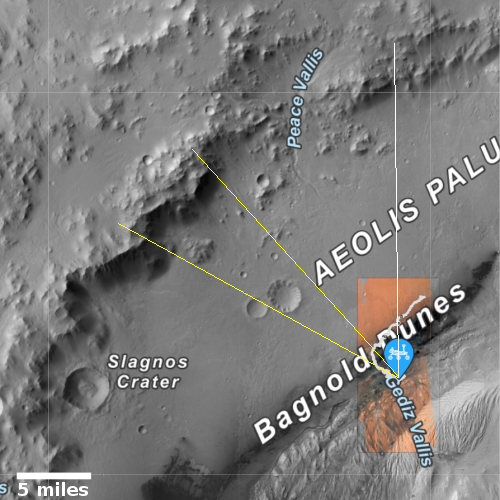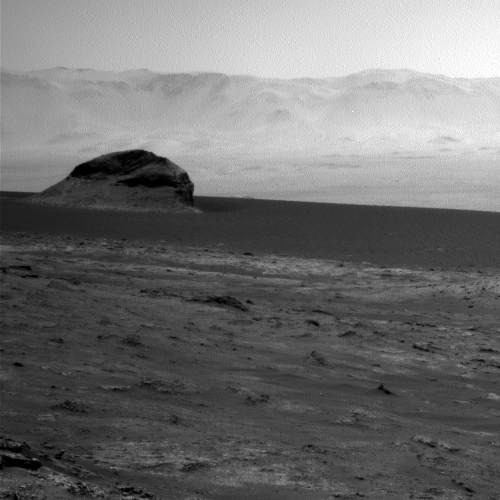Curiosity looks across at the alien landscape of Gale Crater
Most of the images from Curiosity that I have posted recently have been of the spectacular mountain scenery looking south at Mount Sharp itself. Today’s cool image, taken on July 6, 2021 by the rover’s right navigation camera and cropped to post here, instead looks north, out across the floor of Gale Crater to its distant rim about twenty miles away.
The rover is likely not to move for a week or so, as it has just completed drilling its first drillhole since it moved up into the next geological layer, dubbed the sulfate unit. Because of this they have been using the rover’s cameras to take a lot of pictures of the surrounding terrain, including several high resolution mosaics.
The two overview maps below show what the cool image above is looking at.

Click for interactive map.

The yellow lines on both maps indicate approximately what is seen in the cropped image above. The white line shows the additional area covered by the full uncropped photo.
What drew me to this photo was the striking mesa sticking up in the midst of the dune field that Curiosity has been circling for the past year. I estimate it is about 100 feet high, and appears quite dramatic on that flat sea of sand dunes.
The image also gives us a sense of how far Curiosity has now climbed since it landed on the floor of Gale Crater. I estimate it has now gained about 5,000 feet of the 14,000 feet it needs to climb to get the the peak of Mount Sharp.
The distant mountains are Gale Crater’s northern rim. In the full image you can see the gap into Peace Valley, one of the major gaps in the rim of the crater, and thought to have been a major inlet when the crater floor was covered in either water or ice.
The cool image however expresses the alienness of this terrain. While someone from the American southwest might think it looks familiar, a closer look always proves otherwise. There is no visible life here. The surface is barren, and formed by inanimate geology with no modifications of any kind from plant or animal life.
Someday, in the far future, I hope humans will change this view, and make it bloom with life.
On Christmas Eve 1968 three Americans became the first humans to visit another world. What they did to celebrate was unexpected and profound, and will be remembered throughout all human history. Genesis: the Story of Apollo 8, Robert Zimmerman's classic history of humanity's first journey to another world, tells that story, and it is now available as both an ebook and an audiobook, both with a foreword by Valerie Anders and a new introduction by Robert Zimmerman.
The print edition can be purchased at Amazon or from any other book seller. If you want an autographed copy the price is $60 for the hardback and $45 for the paperback, plus $8 shipping for each. Go here for purchasing details. The ebook is available everywhere for $5.99 (before discount) at amazon, or direct from my ebook publisher, ebookit. If you buy it from ebookit you don't support the big tech companies and the author gets a bigger cut much sooner.
The audiobook is also available at all these vendors, and is also free with a 30-day trial membership to Audible.
"Not simply about one mission, [Genesis] is also the history of America's quest for the moon... Zimmerman has done a masterful job of tying disparate events together into a solid account of one of America's greatest human triumphs."--San Antonio Express-News
Most of the images from Curiosity that I have posted recently have been of the spectacular mountain scenery looking south at Mount Sharp itself. Today’s cool image, taken on July 6, 2021 by the rover’s right navigation camera and cropped to post here, instead looks north, out across the floor of Gale Crater to its distant rim about twenty miles away.
The rover is likely not to move for a week or so, as it has just completed drilling its first drillhole since it moved up into the next geological layer, dubbed the sulfate unit. Because of this they have been using the rover’s cameras to take a lot of pictures of the surrounding terrain, including several high resolution mosaics.
The two overview maps below show what the cool image above is looking at.

Click for interactive map.

The yellow lines on both maps indicate approximately what is seen in the cropped image above. The white line shows the additional area covered by the full uncropped photo.
What drew me to this photo was the striking mesa sticking up in the midst of the dune field that Curiosity has been circling for the past year. I estimate it is about 100 feet high, and appears quite dramatic on that flat sea of sand dunes.
The image also gives us a sense of how far Curiosity has now climbed since it landed on the floor of Gale Crater. I estimate it has now gained about 5,000 feet of the 14,000 feet it needs to climb to get the the peak of Mount Sharp.
The distant mountains are Gale Crater’s northern rim. In the full image you can see the gap into Peace Valley, one of the major gaps in the rim of the crater, and thought to have been a major inlet when the crater floor was covered in either water or ice.
The cool image however expresses the alienness of this terrain. While someone from the American southwest might think it looks familiar, a closer look always proves otherwise. There is no visible life here. The surface is barren, and formed by inanimate geology with no modifications of any kind from plant or animal life.
Someday, in the far future, I hope humans will change this view, and make it bloom with life.
On Christmas Eve 1968 three Americans became the first humans to visit another world. What they did to celebrate was unexpected and profound, and will be remembered throughout all human history. Genesis: the Story of Apollo 8, Robert Zimmerman's classic history of humanity's first journey to another world, tells that story, and it is now available as both an ebook and an audiobook, both with a foreword by Valerie Anders and a new introduction by Robert Zimmerman.
The print edition can be purchased at Amazon or from any other book seller. If you want an autographed copy the price is $60 for the hardback and $45 for the paperback, plus $8 shipping for each. Go here for purchasing details. The ebook is available everywhere for $5.99 (before discount) at amazon, or direct from my ebook publisher, ebookit. If you buy it from ebookit you don't support the big tech companies and the author gets a bigger cut much sooner.
The audiobook is also available at all these vendors, and is also free with a 30-day trial membership to Audible.
"Not simply about one mission, [Genesis] is also the history of America's quest for the moon... Zimmerman has done a masterful job of tying disparate events together into a solid account of one of America's greatest human triumphs."--San Antonio Express-News



Metallica
“I Disappear” (2008)
https://youtu.be/ekZTW2r4vb4
4:28
North By Northwest (1959)
“Where There Ain’t No Crops…”
https://youtu.be/EK1o6ixoe_I
3:56
And the Cool Images just keep on coming from the American Mars effort. Curious why ‘Peace Vallis’ isn’t ‘Pace Vallis’?